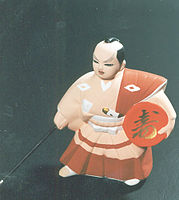Sake set
This articleneeds additional citations forverification.(November 2007) |

Asakeset(Đồ uống rượu,shuki)consists of theflaskandcupsused to servesake.Sakesets are commonlyceramic,but may be wood,lacqueredwood,glassorplastic.The flask and cups may be sold individually or as a set.
Server[edit]

The server of asakeset is a flask called atokkuri(Đức lợi). Atokkuriis generally bulbous with a narrow neck, but may have a variety of other shapes, including that of a spouted serving bowl (katakuchi). Traditionally, heatedsakeis often warmed by placing thesake-filledtokkuriin a pan of hot water, and thus the narrowed neck would prevent the heat from escaping. In more authentic places such asodenbars andryōteiin Japan, sake is sometimes warmed and served in metal containers known aschirori(Diêu li)[1][2][3][4]ortanpo(Canh bà).[5]Recently, glasschiroriare also used to chill sake.[6]
Drinking cups[edit]
Formerly, sake was sold by volume in a wooden box measuring cup, known as amasu[7]which has a volume of onegō(180 ml, 6.3 imp fl oz, 6.1 US fl oz) and was also used to drink. In the past, the wooden box was said to complement the traditionally brewed sake, as it is brewed in a woodencask(Tôn), but in modern times, the masu is shunned by sake purists because the wood affects the flavor of the sake. Furthermore, tradition requires the masu be filled to the rim as a sign of prosperity. Masu are now commonly made oflacquerwareor even ofABS plastic.As the traditional sake-serving cup and a symbol of prosperity due to sharing the same pronunciation as the Japanese word for increase/proliferate (Tăng す), the masu is still used in modern times for the purpose of ceremony or to show generosity. In some Japanese restaurants, the server may put a glass inside themasu(or put themasuinside a saucer) and pour until the sake overflows and spills into the secondary container to symbolize this wealth.
Nowadays, the sake is typically served in ceramic cups. The cups used for drinking sake are generally small cylindrical vessels calledo-chokoorchoko(Heo khẩu,o- is anhonorific prefix in Japaneseused such aso-sakeando-makase), but may also include flatter shapes such as wide-mouthed bowls.Sakazukiare ceremonial cups used most commonly at weddings and other special occasions such astea ceremonies,but larger versions ofsakazukialso exist.
While not a traditional serving utensil, ashot glassis also used. In theUnited States,it is used as a substitute for ochoko, while in Japan it is used in conjunction withmasu.Sakestemwareis also used, which is essentially a glass sake cup elevated above a wide base. Sake stemware, as well as glass tokkuri, are now commonly used to serve chilled sake.
-
A decorated lacquermasu
-
Overflowing glass inside themasu
-
The bride is sipping sake from asakazukiinsan-san-kudo(Tam tam chín độ) ritual in a Japanese wedding. A woman on the right is holding achōshi(Cái siêu) sake server. FromSketches of Japanese Manners and Customs, Illustrated by Native Drawings...by J. M. W. Silver, published in London in 1867.
-
A dancingHakata ningyōdoll holding a largesakazuki(Kurodabushi)
References[edit]
- ^James Curtis Hepburn"Chirori",A Japanese and English dictionary: with an English and Japanese index,American Presbyterian MissionPress (Shanghai), 1867, p. 41.
- ^(in Japanese)"Diêu li",kotobank/Asahi Shimbun,accessdate=2010-12-22.
- ^(in Japanese)"お lạn グッズ bổn cách phái tích chế ちろり",Japan Prestige Sake Association,accessdate=2010-12-22.
- ^Sepp Linhart"Some Thoughts on the Ken Game in Japan: From the Viewpoint of Comparative Civilization Studies"Archived2011-07-22 at theWayback Machine,Senri Ethnological Studies,40 (1995), p. 101-124.
- ^(in Japanese)"Canh bà",kotobank/Asahi Shimbun,accessdate=2010-12-22.
- ^(in Japanese)"ちろり"Archived2003-10-09 at theWayback Machine,Dewazakura Sake Brewery Corporation,accessdate=2010-12-22.
- ^(in Japanese)"枡 rượu",Yahoo! Japan Dictionary/Nước Nhật ngữ đại từ điển,accessdate=2010-12-22.
External links[edit]
- Sake Flask Shapes Guide
- Tokkuri- Sake Flask Shapes
- Yoshio Tsuchiya, Masaru Yamamoto (food styling), Eiji Kori (photography),Juliet Winters Carpenter(translation)"Saké servers",The Fine Art of Japanese Food Arrangement,Kodansha International(Tokyo), 2002, p. 70.ISBN978-4-7700-2930-0




